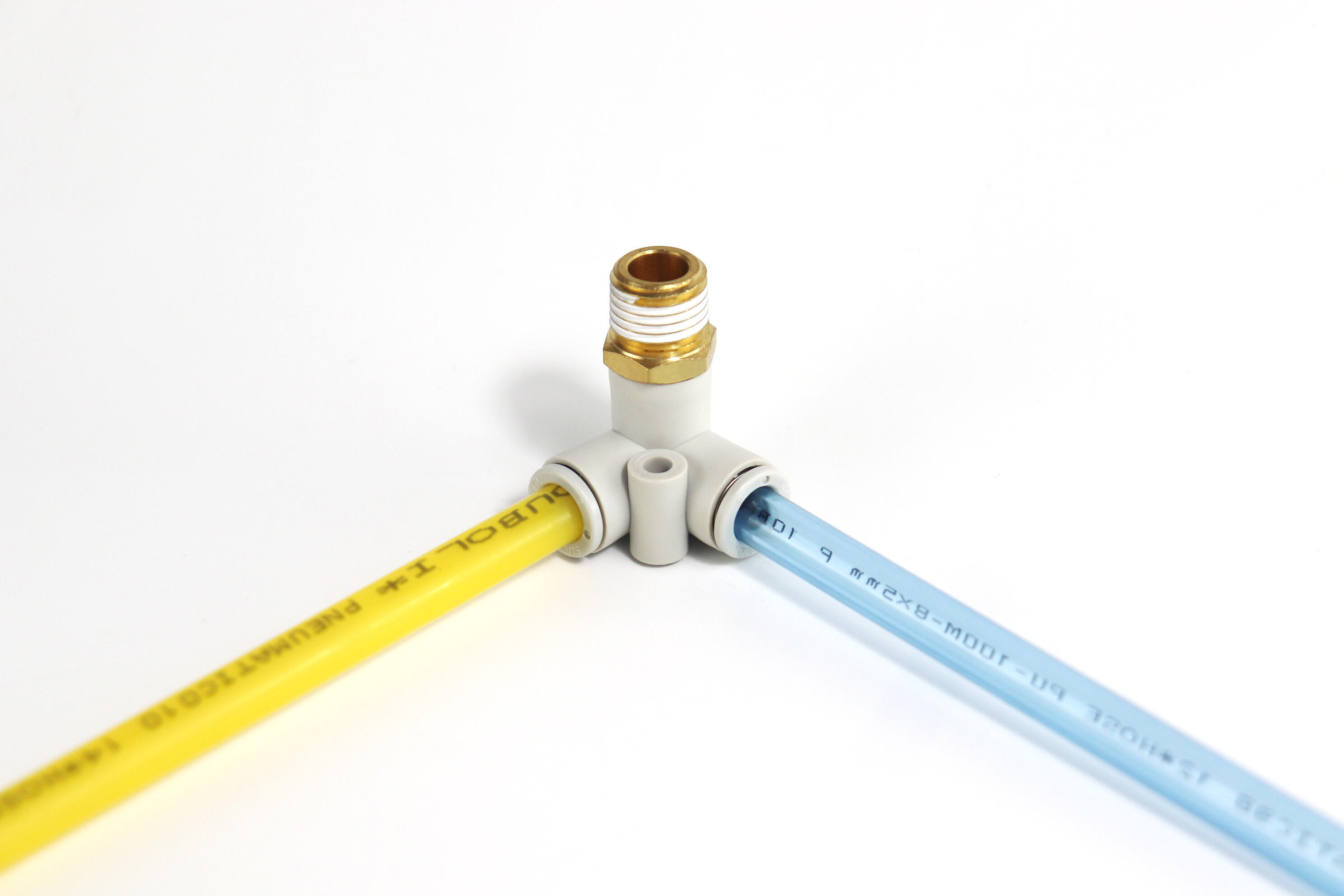Κατανόηση των Βασικών Αρχών των Συνδέσεων Πνευματικών Συστημάτων
Η αξιοπιστία οποιουδήποτε πνευματικού συστήματος εξαρτάται σε μεγάλο βαθμό από την ποιότητα και τη σωστή εγκατάσταση των εφοδιασμοί αερόστατων σωλήνων αυτά τα απαραίτητα εξαρτήματα λειτουργούν ως οι κρίσιμοι κρίκοι που διατηρούν την πίεση του αέρα, αποτρέπουν διαρροές και εξασφαλίζουν την ομαλή λειτουργία του πνευματικού εξοπλισμού. Ωστόσο, ακόμη και έμπειροι επαγγελματίες συντήρησης συχνά αντιμετωπίζουν προβλήματα με αυτά τα ζωτικής σημασίας σημεία σύνδεσης.
Τα πνευματικά εξαρτήματα σωληνώσεων υπάρχουν σε διάφορα σχήματα, μεγέθη και υλικά, τα οποία σχεδιάζονται για συγκεκριμένες εφαρμογές και συνθήκες λειτουργίας. Από ορείχαλκο και ανοξείδωτο ατσάλι μέχρι σύνθετα υλικά, η επιλογή των κατάλληλων εξαρτημάτων μπορεί να επηρεάσει σημαντικά την απόδοση του συστήματος. Η κατανόηση αυτών των εξαρτημάτων και των συνηθισμένων προβλημάτων τους αποτελεί το πρώτο βήμα προς τη διατήρηση ενός αποδοτικού πνευματικού συστήματος.
Επιλογή Υλικών και Περιβαλλοντικοί Παράγοντες
Επίπτωση των Περιβαλλοντικών Συνθηκών
Το περιβάλλον όπου λειτουργούν τα πνευματικά εξαρτήματα σωληνώσεων έχει καθοριστικό ρόλο στην απόδοση και τη διάρκεια ζωής τους. Οι διακυμάνσεις θερμοκρασίας, τα επίπεδα υγρασίας και η έκθεση σε χημικές ουσίες μπορούν όλα να επηρεάσουν την ακεραιότητα αυτών των εξαρτημάτων. Σε περιβάλλοντα υψηλής θερμοκρασίας, ορισμένα υλικά μπορεί να διασταλούν ή να γίνουν εύθραυστα, ενώ τα διαβρωτικά περιβάλλοντα μπορούν να επιταχύνουν τη φθορά των μεταλλικών εξαρτημάτων.
Η επιλογή εξαρτημάτων που ταιριάζουν στις συνθήκες του περιβάλλοντός σας είναι απαραίτητη. Τα πνευματικά εξαρτήματα σωληνώσεων από ανοξείδωτο ατσάλι προσφέρουν εξαιρετική αντοχή στη διάβρωση, αλλά έχουν υψηλότερο κόστος. Τα εξαρτήματα από ορείχαλκο προσφέρουν καλή σχέση τιμής-ποιότητας και αντοχή σε συνηθισμένες συνθήκες, ενώ τα σύνθετα υλικά μπορεί να είναι ιδανικά για συγκεκριμένα χημικά περιβάλλοντα.
Σκέψεις για τη συμβατότητα υλικών
Κατά τον σχεδιασμό πνευματικών συστημάτων, η συμβατότητα των υλικών μεταξύ των εξαρτημάτων και των σωλήνων είναι κρίσιμη. Η ανάμειξη ασύμβατων υλικών μπορεί να οδηγήσει σε πρόωρη φθορά, διαρροές ή πλήρη αποτυχία του συστήματος. Για παράδειγμα, η χρήση εξαρτημάτων από ορείχαλκο με ορισμένα είδη πλαστικών σωλήνων μπορεί να προκαλέσει ρωγμές λόγω τάσης με την πάροδο του χρόνου.
Λάβετε υπόψη τις χημικές ιδιότητες τόσο των εξαρτημάτων όσο και του μέσου που διέρχεται από αυτά. Ορισμένα λιπαντικά και καθαριστικά μπορεί να επιφέρουν την αποδόμηση συγκεκριμένων υλικών, γεγονός που καθιστά απαραίτητο τον έλεγχο της συμβατότητας πριν από την εγκατάσταση.

Προκλήσεις στην εγκατάσταση και συναρμολόγηση
Σωστές τεχνικές αποβάθμισης και στεγανοποίησης
Ένα από τα πιο συνηθισμένα προβλήματα με τα πνευματικά εξαρτήματα σωλήνων προκύπτει από λανθασμένη αποβάθμιση και στεγανοποίηση κατά την εγκατάσταση. Η υπερβολική σφίξιμο μπορεί να καταστρέψει τα σπειρώματα ή να σπάσει τα εξαρτήματα, ενώ η ελλιπής σφίξιμο οδηγεί σε διαρροές. Η χρήση του σωστού στεγανωτικού σπειρώματος ή ταινίας είναι κρίσιμη, αλλά η υπερβολική εφαρμογή μπορεί να εισωθεί υλικό στο σύστημα και να προκαλέσει εμφράξεις.
Οι επαγγελματίες εγκαταστάτες συνιστούν τη χρήση ταινίας PTFE, τυλιγμένης προς την κατεύθυνση του σπειρώματος, με όχι περισσότερες από τρεις στροφές γύρω από το εξάρτημα. Αυτό διασφαλίζει επαρκή στεγανοποίηση χωρίς να κινδυνεύει ο εγκλωβισμός ρύπων στο σύστημα. Για μόνιμες εγκαταστάσεις, τα υγρά στεγανωτικά σπειρωμάτων μπορεί να δώσουν καλύτερα αποτελέσματα, αλλά απαιτούν επαρκή χρόνο σκλήρυνσης.
Ευθυγράμμιση και Πρόληψη Τάσης
Η εσφαλμένη ευθυγράμμιση των πνευματικών εξαρτημάτων σωλήνωσης δημιουργεί σημεία έντασης που μπορεί να οδηγήσουν σε διαρροές ή αποτυχία. Η σωστή σχεδίαση του συστήματος θα πρέπει να λαμβάνει υπόψη τη θερμική διαστολή και τη δόνηση, ενσωματώνοντας εύκαμπτες συνδέσεις όπου απαιτείται. Η κατάλληλη στήριξη των σωλήνων εμποδίζει το υπερβολικό βάρος να τραβά τα σημεία σύνδεσης.
Κατά την εγκατάσταση, βεβαιωθείτε ότι τα εξαρτήματα είναι σωστά ευθυγραμμισμένα πριν το τελικό σφίξιμο. Η χρήση εργαλείων ευθυγράμμισης και η ακριβής ακολουθία των προδιαγραφών του κατασκευαστή βοηθούν στην πρόληψη μελλοντικών προβλημάτων. Να θυμάστε ότι ακόμη και μια ελαφριά εκτροπή μπορεί να δημιουργήσει σημαντική τάση με την πάροδο του χρόνου, ειδικά σε συστήματα υψηλής πίεσης ή με συχνές αλλαγές πίεσης.
Στρατηγικές Διαχείρισης και Επισκευής
Πρωτόκολλα Προληπτικής Διατροφής
Η τακτική επιθεώρηση των εξαρτημάτων πνευματικών σωληνώσεων βοηθά στον εντοπισμό πιθανών προβλημάτων πριν γίνουν σοβαρά. Καθιερώστε ένα πρόγραμμα συντήρησης που περιλαμβάνει έλεγχο για χαλαρές συνδέσεις, ορατές βλάβες και σημάδια διάβρωσης. Χρησιμοποιήστε διαλύματα ανίχνευσης διαρροών ή υπερηχητικό εξοπλισμό δοκιμής για να εντοπίσετε μικρές διαρροές που διαφορετικά θα παρέμεναν αδιάγνωστες.
Καταγράψτε όλες τις δραστηριότητες συντήρησης και δημιουργήστε μια βάση δεδομένων με συνηθισμένα προβλήματα και λύσεις. Οι πληροφορίες αυτές αποδεικνύονται ανεκτίμητες για την αντιμετώπιση προβλημάτων και μπορούν να βοηθήσουν στον εντοπισμό μοτίβων που ίσως υποδεικνύουν συστημικά προβλήματα που απαιτούν προσοχή.
Προηγμένες Τεχνικές Διαγνώσεως
Οι σύγχρονες προσεγγίσεις συντήρησης ενσωματώνουν διάφορα διαγνωστικά εργαλεία για την αξιολόγηση της κατάστασης των εξαρτημάτων πνευματικών σωληνώσεων. Η θερμογράφηση μπορεί να εντοπίσει μεταβολές θερμοκρασίας που ίσως υποδηλώνουν διαρροές ή περιορισμούς, ενώ η δοκιμή πίεσης βοηθά στην επαλήθευση της ακεραιότητας του συστήματος. Αυτές οι προηγμένες τεχνικές επιτρέπουν στις ομάδες συντήρησης να εντοπίζουν προβλήματα πριν οδηγήσουν σε αποτυχία του συστήματος.
Η εκπαίδευση του προσωπικού συντήρησης σε αυτές τις διαγνωστικές μεθόδους εξασφαλίζει συνεπή και αποτελεσματική παρακολούθηση του συστήματος. Η τακτική βαθμονόμηση του εξοπλισμού δοκιμών και η διατήρηση λεπτομερών αρχείων των αποτελεσμάτων των δοκιμών βοηθούν στην παρακολούθηση της απόδοσης του συστήματος με την πάροδο του χρόνου.
Μελλοντικές Τάσεις και Τεχνολογικές Εξελίξεις
Έξυπνα Συστήματα Παρακολούθησης
Η ενσωμάτωση της τεχνολογίας IoT με τα πνευματικά συστήματα μεταμορφώνει τον τρόπο με τον οποίο παρακολουθούμε και συντηρούμε τα πνευματικά εξαρτήματα σωληνώσεων. Οι έξυπνοι αισθητήρες μπορούν πλέον να παρακολουθούν συνεχώς την πίεση, τη θερμοκρασία και τις ταχύτητες ροής, παρέχοντας πραγματικά δεδομένα για την απόδοση του συστήματος. Αυτές οι πληροφορίες επιτρέπουν στις ομάδες συντήρησης να προβλέπουν πιθανές βλάβες και να προγραμματίζουν αποτελεσματικότερα την προληπτική συντήρηση.
Τα αυτοματοποιημένα συστήματα παρακολούθησης μπορούν να ειδοποιούν το προσωπικό συντήρησης για μικρές αλλαγές στην απόδοση του συστήματος που ενδέχεται να υποδεικνύουν αναπτυσσόμενα προβλήματα στα εξαρτήματα ή τις συνδέσεις. Αυτή η προβλεπτική προσέγγιση βοηθά στην αποφυγή απρόβλεπτων διακοπών και μειώνει το κόστος συντήρησης.
Καινοτόμα Υλικά και Σχεδιασμοί
Οι κατασκευαστές συνεχίζουν να αναπτύσσουν νέα υλικά και σχέδια για πνευματικά εξαρτήματα σωληνώσεων που προσφέρουν βελτιωμένη απόδοση και αξιοπιστία. Τα αυτοσφραγιζόμενα εξαρτήματα, τα συστήματα γρήγορης σύνδεσης και τα σύνθετα υλικά με ενισχυμένη ανθεκτικότητα αλλάζουν τον τρόπο με τον οποίο συναρμολογούνται και συντηρούνται τα πνευματικά συστήματα. Αυτές οι καινοτομίες επικεντρώνονται στη μείωση του χρόνου εγκατάστασης, ενώ βελτιώνουν την αξιοπιστία του συστήματος.
Η ανάπτυξη έξυπνων εξαρτημάτων με ενσωματωμένους αισθητήρες αποτελεί την επόμενη εξέλιξη στα εξαρτήματα πνευματικών συστημάτων. Αυτά τα προηγμένα εξαρτήματα μπορούν να παρέχουν άμεση ανατροφοδότηση σχετικά με την κατάσταση και την απόδοσή τους, βελτιώνοντας περαιτέρω τις δυνατότητες συντήρησης.
Συχνές Ερωτήσεις
Πόσο συχνά πρέπει να ελέγχονται τα πνευματικά εξαρτήματα σωληνώσεων;
Οι τακτικοί έλεγχοι πρέπει να πραγματοποιούνται τουλάχιστον τρεις φορές το χρόνο, με πιο συχνούς ελέγχους σε εφαρμογές υψηλής έντασης ή κρίσιμες. Τα συστήματα που λειτουργούν σε δύσκολα περιβάλλοντα ή υπό υψηλές πιέσεις μπορεί να απαιτούν μηνιαίους ελέγχους για να διασφαλιστεί η βέλτιστη απόδοση και ασφάλεια.
Ποια είναι τα σημάδια αποτύχουσας πνευματικής σωλήνωσης;
Συνηθισμένοι δείκτες περιλαμβάνουν ακουστά διαρροές αέρα, μείωση της πίεσης του συστήματος, ασυνήθιστους θορύβους ή δονήσεις, ορατή διάβρωση ή ζημιά και αυξημένη κατανάλωση ενέργειας. Η τακτική παρακολούθηση μπορεί να βοηθήσει στην έγκαιρη ανίχνευση αυτών των σημαδιών, αποτρέποντας σοβαρότερα προβλήματα.
Ποιος είναι ο καλύτερος τρόπος για να αποφευχθούν οι διαρροές στις πνευματικές συνδέσεις σωληνώσεων;
Η σωστή εγκατάσταση με τη χρήση κατάλληλων εργαλείων και τεχνικών, η τακτική συντήρηση και η επιλογή των σωστών υλικών σύνδεσης για την εφαρμογή σας είναι κρίσιμα. Η χρήση ποιοτικών σφραγιστικών σπειρωμάτων, η διασφάλιση σωστής ευθυγράμμισης και η τήρηση των προδιαγραφών ροπής του κατασκευαστή βοηθούν επίσης στην πρόληψη διαρροών.
Πώς μπορώ να καθορίσω το σωστό μέγεθος για πνευματικές συνδέσεις σωληνώσεων;
Εξετάστε παράγοντες όπως ο απαιτούμενος ρυθμός ροής, η πίεση του συστήματος και ο τύπος σύνδεσης. Συμβουλευτείτε τις προδιαγραφές του κατασκευαστή και τις απαιτήσεις σχεδίασης του συστήματος. Σε περίπτωση αμφιβολίας, συνεργαστείτε με έναν εξειδικευμένο σχεδιαστή πνευματικού συστήματος για να διασφαλίσετε τη σωστή διάσταση για την εφαρμογή σας.
Πίνακας Περιεχομένων
- Κατανόηση των Βασικών Αρχών των Συνδέσεων Πνευματικών Συστημάτων
- Επιλογή Υλικών και Περιβαλλοντικοί Παράγοντες
- Προκλήσεις στην εγκατάσταση και συναρμολόγηση
- Στρατηγικές Διαχείρισης και Επισκευής
- Μελλοντικές Τάσεις και Τεχνολογικές Εξελίξεις
-
Συχνές Ερωτήσεις
- Πόσο συχνά πρέπει να ελέγχονται τα πνευματικά εξαρτήματα σωληνώσεων;
- Ποια είναι τα σημάδια αποτύχουσας πνευματικής σωλήνωσης;
- Ποιος είναι ο καλύτερος τρόπος για να αποφευχθούν οι διαρροές στις πνευματικές συνδέσεις σωληνώσεων;
- Πώς μπορώ να καθορίσω το σωστό μέγεθος για πνευματικές συνδέσεις σωληνώσεων;

